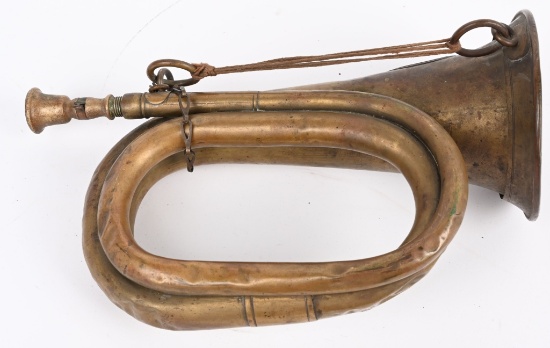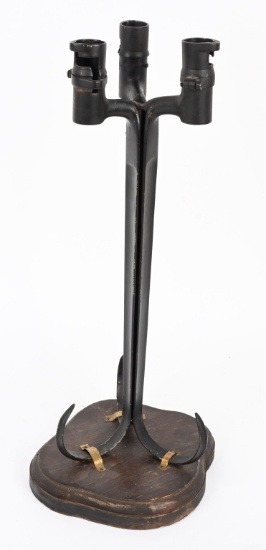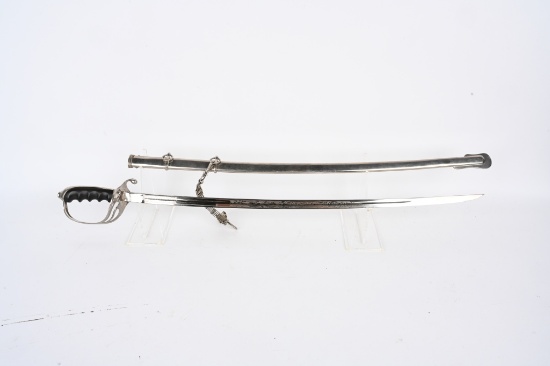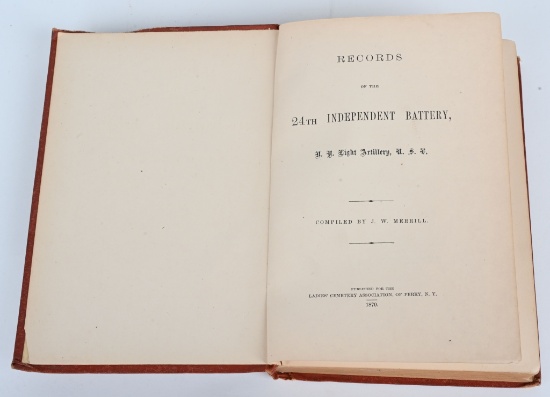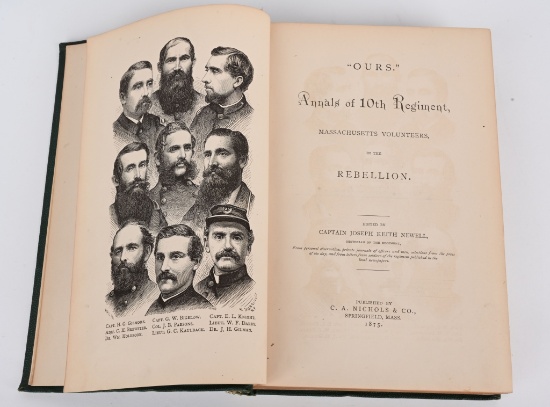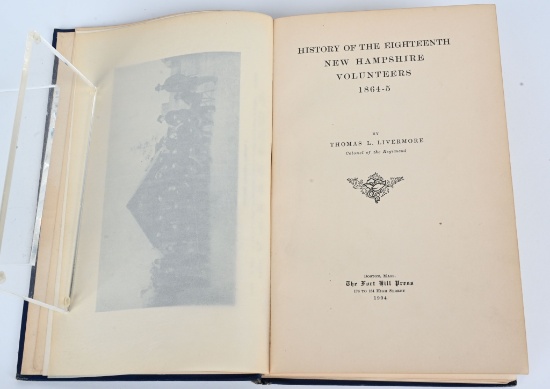Lot # 135 (Sale Order: 150 of 896)
Low Estimate: 200High Estimate: 300
Civil War unit history of the 18th New Hampshire Infantry published in 1904 having a complete roster of the Infantry Regiment. Covers show wear but the book is still very sound. By THOMAS L. LIVERMORE, late Colonel Eighteenth Regiment New Hampshire Volunteer Infantry. SIX companies of this regiment (A to F) were raised under the call of the president, July 18, 1864. They joined the Engineer Brigade, commanded by General Benham, at City Point, Va., October 4, 1864. Charles H. Bell, of Exeter, was appointed colonel, and James W. Carr, of Manchester, lieutenant-colonel, but both declined the commissions. October 13, Joseph M. Clough, of New London, lately a captain in the Fourth New Hampshire Volunteers, was commissioned lieutenant colonel, and William I. Brown, of Fisherville, then adjutant of the Ninth New Hampshire Volunteers, was commissioned major, and in the same month they joined the first six companies at City Point. Although the quota of the State, under the call of July 18, was completed, Governor Gilmore, by proclamation, October 13, caused enlistments for the last four companies to proceed in advance of the next call of the president of December 19, under which proclamation and call the regiment was completed. It was composed of excellent material. The members were almost entirely citizens of the State. A good many of them had seen service in other organizations, and the remainder were good men, whose delay in volunteering may fairly be presumed to have been justifiable. January 17, 1865, Thomas L. Livermore, of Milford, then major of the Fifth New Hampshire Volunteers, and acting assistant inspector-general of the Second Army Corps, on the staff of Major-General Humphries, was commissioned colonel. His muster was deferred under the regulation of the War Department that a regiment should not be entitled to a colonel until it had ten companies. Companies G and H joined the regiment at City Point in February, and Company I joined at Petersburg, in March. The tenth company (K) was mustered into service April 6, but on account of Lee's surrender, was detained at Galloup's Island, Boston Harbor, until May 6, when it was mustered out of service. The regiment remained a part of Benham's brigade until March 19, and was employed for some weeks in labor on the fortifications of City Point. December 10 the brigade moved, in severe weather, to the lines in front of Petersburg, and there occupied the works to the left of Fort Davis for several days. December 18, as a part of a temporary brigade detached under Lieutenant-Colonel Clough, it labored two weeks on the works at Bermuda Hundred, under order of General Ferrero; February 5, in Benham's brigade, the regiment marched to the front of Petersburg, and remained there a week. March 19, by order of General Meade, commanding the Army of the Potomac, the regiment was detached from Benham's brigade, and ordered to report to the commander of the Ninth Army Corps, to be disbanded and distributed among the New Hampshire regiments of that command. The personal intercession of Colonel Livermore at army headquarters, caused the order for disbandment to be revoked. Having reported to General Parke, commanding the Ninth Army Corps, March 25 the regiment supported the Eleventh Massachusetts Battery, in the engagement in which Fort Stedman was recaptured from the enemy, and on the same day it was assigned to the Third Brigade, First Division, Ninth Army Corps, and was posted in Fort Stedman, where it remained, under constant fire, until the fall of Petersburg. March 29 the regiment repelled a night attack, in which Major Brown was killed and Lieutenant-Colonel Clough was slightly wounded, and several enlisted men were killed and wounded. April 2 the regiment made ready for an assault on the enemy's line, which the division was ordered to make. Captain Greenough was wounded while forming the three companies which had been placed under his command for the advance party. The assault was countermanded. Later in the day, a skirmish line from the regiment, supported by three of its companies under Captain Potter, was thrown forward, and encountered a strong force, with a loss of one killed and several wounded. April 3 the regiment entered Petersburg, which had been abandoned by the enemy the night before, and then moved up the Southside Railroad to Ford's Station, where it remained until the 20th. Captain Potter was promoted to major April 4, and Colonel Livermore was mustered in and took command April 8. On the 20th the command marched for City Point, where it took steamer and arrived at Alexandria April 26, and then marched to Tennallytown, D. C., where it went into camp with its brigade, which included also the Twenty-ninth, Fifty-seventh, and Fifty-ninth Massachusetts Volunteers and One Hundredth Pennsylvania Volunteers.
Civil War unit history of the 18th New Hampshire Infantry published in 1904 having a complete roster of the Infantry Regiment. Covers show wear but the book is still very
...more sound. By THOMAS L. LIVERMORE, late Colonel Eighteenth Regiment New Hampshire Volunteer Infantry. SIX companies of this regiment (A to F) were raised under the call of the president, July 18, 1864. They joined the Engineer Brigade, commanded by General Benham, at City Point, Va., October 4, 1864. Charles H. Bell, of Exeter, was appointed colonel, and James W. Carr, of Manchester, lieutenant-colonel, but both declined the commissions. October 13, Joseph M. Clough, of New London, lately a captain in the Fourth New Hampshire Volunteers, was commissioned lieutenant colonel, and William I. Brown, of Fisherville, then adjutant of the Ninth New Hampshire Volunteers, was commissioned major, and in the same month they joined the first six companies at City Point. Although the quota of the State, under the call of July 18, was completed, Governor Gilmore, by proclamation, October 13, caused enlistments for the last four companies to proceed in advance of the next call of the president of December 19, under which proclamation and call the regiment was completed. It was composed of excellent material. The members were almost entirely citizens of the State. A good many of them had seen service in other organizations, and the remainder were good men, whose delay in volunteering may fairly be presumed to have been justifiable. January 17, 1865, Thomas L. Livermore, of Milford, then major of the Fifth New Hampshire Volunteers, and acting assistant inspector-general of the Second Army Corps, on the staff of Major-General Humphries, was commissioned colonel. His muster was deferred under the regulation of the War Department that a regiment should not be entitled to a colonel until it had ten companies. Companies G and H joined the regiment at City Point in February, and Company I joined at Petersburg, in March. The tenth company (K) was mustered into service April 6, but on account of Lee's surrender, was detained at Galloup's Island, Boston Harbor, until May 6, when it was mustered out of service. The regiment remained a part of Benham's brigade until March 19, and was employed for some weeks in labor on the fortifications of City Point. December 10 the brigade moved, in severe weather, to the lines in front of Petersburg, and there occupied the works to the left of Fort Davis for several days. December 18, as a part of a temporary brigade detached under Lieutenant-Colonel Clough, it labored two weeks on the works at Bermuda Hundred, under order of General Ferrero; February 5, in Benham's brigade, the regiment marched to the front of Petersburg, and remained there a week. March 19, by order of General Meade, commanding the Army of the Potomac, the regiment was detached from Benham's brigade, and ordered to report to the commander of the Ninth Army Corps, to be disbanded and distributed among the New Hampshire regiments of that command. The personal intercession of Colonel Livermore at army headquarters, caused the order for disbandment to be revoked. Having reported to General Parke, commanding the Ninth Army Corps, March 25 the regiment supported the Eleventh Massachusetts Battery, in the engagement in which Fort Stedman was recaptured from the enemy, and on the same day it was assigned to the Third Brigade, First Division, Ninth Army Corps, and was posted in Fort Stedman, where it remained, under constant fire, until the fall of Petersburg. March 29 the regiment repelled a night attack, in which Major Brown was killed and Lieutenant-Colonel Clough was slightly wounded, and several enlisted men were killed and wounded. April 2 the regiment made ready for an assault on the enemy's line, which the division was ordered to make. Captain Greenough was wounded while forming the three companies which had been placed under his command for the advance party. The assault was countermanded. Later in the day, a skirmish line from the regiment, supported by three of its companies under Captain Potter, was thrown forward, and encountered a strong force, with a loss of one killed and several wounded. April 3 the regiment entered Petersburg, which had been abandoned by the enemy the night before, and then moved up the Southside Railroad to Ford's Station, where it remained until the 20th. Captain Potter was promoted to major April 4, and Colonel Livermore was mustered in and took command April 8. On the 20th the command marched for City Point, where it took steamer and arrived at Alexandria April 26, and then marched to Tennallytown, D. C., where it went into camp with its brigade, which included also the Twenty-ninth, Fifty-seventh, and Fifty-ninth Massachusetts Volunteers and One Hundredth Pennsylvania Volunteers.less...
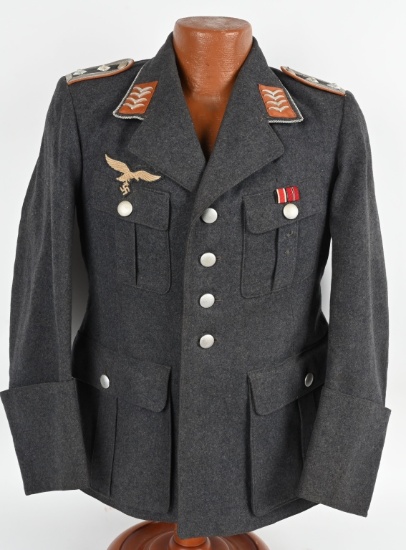


 x Cancel
x Cancel
